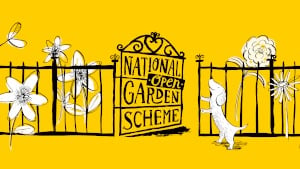About The Circles Garden
I moved to this house and garden in 1998 when it was virtually all grass. The garden is at 415 feet above sea level, faces west, slopes away from the house and has heavy clay soil, with coal, shale and ironstone.
The garden was created in the late 1960s when part of the neighbouring Spring Wood was cleared to build the house. It looks onto fields and woods and has a nature reserve opposite which is home to endangered newts and some rare flowers and insects.
Developing the garden, took 9 years and when I began, I stacked all the turf I dug from the new beds and borders and I am now self-sufficient in potting soil. I make compost and leaf mould yearly and along with bonfire ash, use this to improve and fertilise the soil. Since there is no mains-drainage in Midgley, the garden is watered naturally by run-off from the house roof and septic tank and by watering can from the barrel collecting rainwater from the garage roof. The only products I buy are small amounts of organic composted horse manure, organic seaweed fertiliser and slug pellets.
I brought plants from my previous garden including snowdrops which originated in my great-grandfather’s garden. I grew plants from RHS and my own seed, and propagated my stock. When there were enough plants, I developed a new bed or border. It was a very gradual process, though I occasionally rewarded myself with a plant buying trip to Beth Chatto`s garden after working on a particularly hard development!
I started propagating Helleborus orientallis from the 3 different plants I brought from my old garden, plus a yellow flowered plant that I bought, originally to fill the beds and borders with plants with elegant leaves and flowers. There are double flowers with different colours and markings, and a few anemone-flowered plants, as well as single flowers with a huge variety of colours and markings.
The name, the Circles Garden, came about after I had the front lawn removed, a retaining wall built and a small and incomplete version of Avebury prehistoric stone circle erected. Although “small” in comparison to the original, some of the stones are 5 feet tall above ground. There are other circles in the garden of various types and dimensions, so the name seemed appropriate.

.jpg)
.jpg)
.jpg)
.jpg)
.jpg)
.jpg)
.jpg)
.jpg)
.jpg)
.jpg)
.jpg)
.jpg)
.jpg)
.jpg)


.jpg)
.jpg)
.jpg)
.jpg)
.jpg)

.jpg)
.jpg)